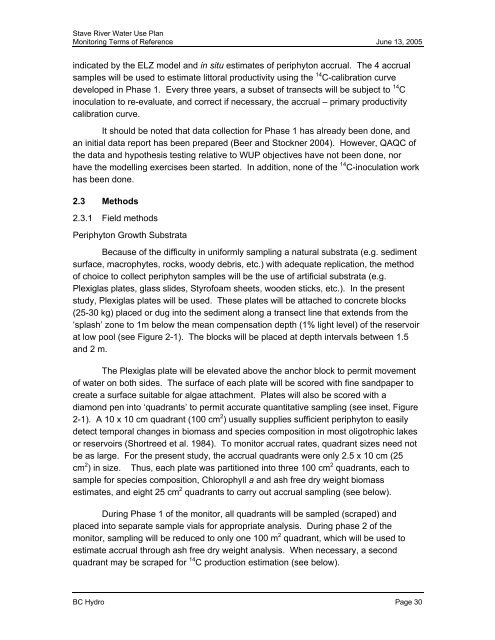Stave River Water Use Plan - BC Hydro
Stave River Water Use Plan - BC Hydro
Stave River Water Use Plan - BC Hydro
You also want an ePaper? Increase the reach of your titles
YUMPU automatically turns print PDFs into web optimized ePapers that Google loves.
<strong>Stave</strong> <strong>River</strong> <strong>Water</strong> <strong>Use</strong> <strong>Plan</strong><br />
Monitoring Terms of Reference June 13, 2005<br />
indicated by the ELZ model and in situ estimates of periphyton accrual. The 4 accrual<br />
samples will be used to estimate littoral productivity using the 14 C-calibration curve<br />
developed in Phase 1. Every three years, a subset of transects will be subject to 14 C<br />
inoculation to re-evaluate, and correct if necessary, the accrual – primary productivity<br />
calibration curve.<br />
It should be noted that data collection for Phase 1 has already been done, and<br />
an initial data report has been prepared (Beer and Stockner 2004). However, QAQC of<br />
the data and hypothesis testing relative to WUP objectives have not been done, nor<br />
have the modelling exercises been started. In addition, none of the 14 C-inoculation work<br />
has been done.<br />
2.3 Methods<br />
2.3.1 Field methods<br />
Periphyton Growth Substrata<br />
Because of the difficulty in uniformly sampling a natural substrata (e.g. sediment<br />
surface, macrophytes, rocks, woody debris, etc.) with adequate replication, the method<br />
of choice to collect periphyton samples will be the use of artificial substrata (e.g.<br />
Plexiglas plates, glass slides, Styrofoam sheets, wooden sticks, etc.). In the present<br />
study, Plexiglas plates will be used. These plates will be attached to concrete blocks<br />
(25-30 kg) placed or dug into the sediment along a transect line that extends from the<br />
‘splash’ zone to 1m below the mean compensation depth (1% light level) of the reservoir<br />
at low pool (see Figure 2-1). The blocks will be placed at depth intervals between 1.5<br />
and 2 m.<br />
The Plexiglas plate will be elevated above the anchor block to permit movement<br />
of water on both sides. The surface of each plate will be scored with fine sandpaper to<br />
create a surface suitable for algae attachment. Plates will also be scored with a<br />
diamond pen into ‘quadrants’ to permit accurate quantitative sampling (see inset, Figure<br />
2-1). A 10 x 10 cm quadrant (100 cm 2 ) usually supplies sufficient periphyton to easily<br />
detect temporal changes in biomass and species composition in most oligotrophic lakes<br />
or reservoirs (Shortreed et al. 1984). To monitor accrual rates, quadrant sizes need not<br />
be as large. For the present study, the accrual quadrants were only 2.5 x 10 cm (25<br />
cm 2 ) in size. Thus, each plate was partitioned into three 100 cm 2 quadrants, each to<br />
sample for species composition, Chlorophyll a and ash free dry weight biomass<br />
estimates, and eight 25 cm 2 quadrants to carry out accrual sampling (see below).<br />
During Phase 1 of the monitor, all quadrants will be sampled (scraped) and<br />
placed into separate sample vials for appropriate analysis. During phase 2 of the<br />
monitor, sampling will be reduced to only one 100 m 2 quadrant, which will be used to<br />
estimate accrual through ash free dry weight analysis. When necessary, a second<br />
quadrant may be scraped for 14 C production estimation (see below).<br />
<strong>BC</strong> <strong>Hydro</strong> Page 30
















